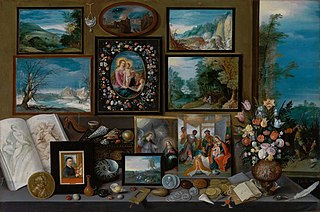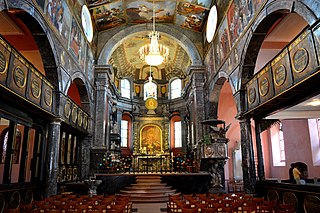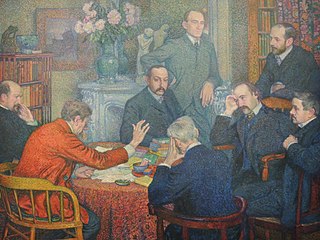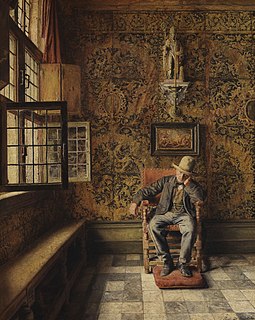 W
WAllegory of the Vanities of the World is a 1663 painting by the Flemish painter Pieter Boel, now in the Palais des Beaux-Arts de Lille. It is unusually large for a vanitas painting.
 W
WThe Archdukes Albert and Isabella Visiting a Collector's Cabinet is a 17th-century Flemish collaborative painting, now regarded as by Jan Brueghel the Elder and Hieronymus Francken II. It is part of the collection of The Walters Art Museum in Baltimore, Maryland.
 W
WBarques de pêche–Méditerranée is an oil on canvas painting by Belgian painter Theo van Rysselberghe. Painted in 1892, it depicts a fleet of sailboats off the southern coast of France. Van Rysselberghe's pontillist technique is well expressed in this work, whose wooden liner was painted with dots of contrasting hues serving to amplify the color harmonies in the canvas. The painting was realized by Van Rysselberghe during a two-month sailing excursion in le Midi with his close friends Paul Signac, and it offers visual representation of that sailing journey.
 W
WA Cabinet of Curiosities is a 1619 oil on panel painting of a cabinet of curiosities by the Flemish painter Frans Francken II. It is now in the Royal Museum of Fine Arts, Antwerp, which bought it in 1903 from the Antwerp-based art dealer Joseph Hallyn.
 W
WCamille Lemonnier in the Artist's Studio is an oil on canvas painting by Belgian painter Alfred Stevens. The portrait was for many years part of a private collection in Paris, but in 2015 it was purchased by the Heritage Found, and is currently housed at the Royal Museums of Fine Arts in Brussels.
 W
WChrist Crowned with Thorns is a c.1500 oil on panel painting by Albrecht Bouts, now in the Musée des Beaux-Arts de Lyon, which acquired it in 2011.
 W
WThe Institution of the Eucharist or Communion of the Apostles is a 1472-1474 tempera on panel painting by Justus van Gent. Commissioned as an altarpiece, it post-dates its 1460s predella, The Miracle of the Desecrated Host by Paolo Uccello. Both Institution and Miracle are now in the Galleria nazionale delle Marche in Urbino.
 W
WDulle Griet, also known as Mad Meg, is a figure of Flemish folklore who is the subject of a 1563 oil-on-panel by Flemish renaissance artist Pieter Bruegel the Elder. The painting depicts a virago, Dulle Griet, who leads an army of women to pillage Hell, and is currently held and exhibited at the Museum Mayer van den Bergh in Antwerp.
 W
WFlora is an oil on wood painting completed in 1559 by the Flemish painter Jan Massys, which is now in the collection of the Kunsthalle Hamburg.
 W
WThe Unionskirche is the active Protestant parish church of Idstein, a town in the Rheingau-Taunus district in the German state of Hesse. Idstein was a residence of the counts of Nassau. The church building in the center of the historic Altstadt dates back to the 14th century when it was built as a collegiate church. It became Lutheran during the Reformation. Its interior was adapted in the 17th century to become a Lutheran "Predigt- und Hofkirche". The most prominent decoration in the church is the series of 38 paintings by the Flemish painter Michael Angelo Immenraedt, an exponent of Flemish Baroque painting, and others. They follow a program of Biblical scenes.
 W
WL'Escaut en amont d'Anvers, le soir or An Evening is an oil on canvas painting by Belgian painter Theo van Rysselberghe. Painted in 1892, the painting is considered a very good example of Van Rysselberghe's pointillist technique, which, by the time he painted this oeuvre, had been completely absorbed and adjusted by the Belgian artist.
 W
WLa parisienne japonaise is an oil on canvas painting by Belgian painter Alfred Stevens. It depicts a young woman in a blue kimono standing in front of a mirror. The painting testifies to Stevens' involvement with Japonisme. Stevens was one of the earliest collectors of Japanese art in Paris.
 W
WLandscape with Grotto and a Rider is an oil on panel painting by Flemish painter Joos de Momper. The painting was completed in the 1610s, possibly in 1616. It is currently housed at the art gallery of Yale University in New Haven, Connecticut.
 W
WLandscape with the Flight into Egypt is a c.1515 panel painting by Joachim Patinir, now in the Royal Museum of Fine Arts, Antwerp.
 W
WLe canal en Flandre par temps triste is an oil on canvas painting by Belgian painter Theo van Rysselberghe.
 W
WMadonna and Child with Saint Catherine of Alexandria and Saint Barbara is a c.1520 oil on panel painting by the Master of Hoogstraeten, an anonymous Antwerp master active between around 1490 and 1530. It is now in the Uffizi Gallery in Florence.
 W
WMaria Sèthe at the Harmonium is an oil on canvas painting by the Belgian neo-impressionist painter Théo van Rysselberghe. The painting depicts a woman with blonde, worn-up hair and a purple dress staring dreamily into space, while smiling. The sitter was Maria Sèthe, who belonged to an affluent musical family with an interest in the arts. In the painting, she is depicted sitting at a harmonium, but she's not playing it.
 W
WMary Magdalene is an oil on canvas painting by Belgian painter Alfred Stevens. It is Stevens' revision of the Biblical figure of Mary Magdalene. The work has been in the collection of the Museum of Fine Arts in Ghent since 2001.
 W
WPallas and Arachne, also known as Minerva Punishing Arachne and occasionally referred to as Arachne Punished by Pallas, is an oil-on-board painting by Flemish artist Peter Paul Rubens completed in 1636 or 1637.
 W
WPortrait of a Seated Woman is an oil on canvas painting by Dutch painter Nicolaes Maes. Its date of execution is unknown. Maes first recorded painting dates back to 1653. Maes, a pupil of Rembrandt, started his career as a painter of biblical and mythological subjects, genre paintings and as a portraitist. He died in 1693. The paintings measures 112,5 x 91,5 cm, and is currently housed at the Royal Museum of Fine Arts in Antwerp.
 W
WPortrait of Irma Sèthe is an oil on canvas painting by the Belgian neo-impressionist painter Théo van Rysselberghe. The work is a portrait, painted in pointillist style, of Irma Sèthe, one of the heiress of a musical Brussels family close to the painter, playing the violin. The work is now in the private collection of the Musée du Petit Palais in Geneva.
 W
WPortrait of Martino Martini is a painting by the Walloon artist Michaelina Wautier. Painted in 1654, it shows the Jesuit missionary Martino Martini. The work hangs in the (private) Klesch collection.
 W
WPortrait of Stephan Geraedts, Husband of Isabella Coymans is an oil on canvas painting by Antwerp-born Dutch Golden Age painter Frans Hals. The painting was originally part of a couple of pendant wedding portraits. Hals probably painted the present portrait, Stephanus Geraerdts', alderman in Haarlem, and the accompanying portrait of the latter's wife Isabella Coymans around 1650-1652, six or seven years after their marriage in 1644. Isabella's portrait is now in a private collection in Paris.
 W
WPortrait of a Noble Young Lady is considered by many art historians, such as Paul Huvenne, former Director of the Royal Museum of Fine Arts Antwerp, to be one of the best examples of Pieter Pourbus' portraiture.
 W
WThe Rider's Halting Place is a painting by the Dutch artist Philips Wouwerman. It was painted in the 17th century, and is now in the Royal Museum of Fine Arts in Antwerp, Belgium.
 W
WSailboats and Estuary is an oil on canvas painting by Belgian painter Theo van Rysselberghe. Painted around 1887, it shows a coastal landscape elaborated in a Pointillist technique. Van Rysselberghe probably adopted the Pointillist manner after befriending Signac; however, the use of color in Sailboats and Esuary is nonetheless far more realistic than in paintings by Signac and other Neo-Impressionists, and reveals a tendency towards naturalism. The artwork has been in the collection of the Musée d'Orsay in Paris since 1982, on loan from the Louvre.
 W
WScenes from the Life and Martyrdom of Saints Catherine and Clement are panels, painted on both sides, with depictions from the life of Saints Catherine and Clement on the inside and grisaille paintings on the outside. They are located in the Saint Peter's Church in Leuven, Belgium. They are the work of the Leuven painter Jan Rombouts the Elder and his workshop and likely created sometime between 1525 and 1535. The dimensions of the panels are about 167 cm high and 70 cm in width. It is not known whether the panels were originally attached to a central painted panel or to a sculpted retable.
 W
WThe Bath is an oil on canvas painting by Belgian painter Alfred Stevens.
 W
WThe Fall of the Rebel Angels is an oil on panel painting by Flemish painter Frans Floris. The painting was the central panel of a triptych. The side panels, however, were lost during the iconoclastic fury in the summer of 1566. The scene represented in the painting stems from Chapter 12 of the Book of Revelation. It is one of Floris' most renowned works, often credited as his most famous painting. Floris painted it for the fencer’s guild of Antwerp, one of the city’s militias, responsible for public security. The altarpiece hung in the Cathedral of Our Lady in Antwerp, above the guild’s altar. Like every other guild or corporation, the fencers had a patron saint, in this case, the Archangel Michael, who leads God's angels against the rebels in the painting.
 W
WThe Judgement of Solomon is an oil on panel painting by Flemish painter Frans Floris. Painted right after Floris' return from his trip to Italy, the painting depicts a biblical scene, the Judgment of Solomon. In that story, King Solomon of Israel ruled between two women who both claimed to be the mother of a child. Solomon revealed their true feelings and relationship to the child by suggesting that the baby be cut in two, with each woman to receive half. With this strategy, Solomon was able to determine the non-mother as the woman who backed this proposal, while the actual mother begged that the sword be sheathed and the child committed to the care of her rival
 W
WThe Lecture of Emile Verhaeren is an oil on canvas painting by Belgian painter Theo van Rysselberghe. Painted 1903, it is currently house at the Museum of Fine Arts in Ghent.
 W
WThe Man in the Chair is an oil on canvas painting by Belgian painter Henri de Braekeleer. The painting is currently housed at the Royal Museum of Fine Arts in Antwerp.
 W
WThe Parisian Sphinx is an oil on canvas painting by Belgian painter Alfred Stevens. Painted between 1875 and 1877, it depicts a dreamy young woman gently supporting her head with her hand. The painting is part of the permanent collection of the Royal Museum of Fine Arts in Antwerp. The Parisian Sphinx shows the influence of Vermeer and the other Netherlandish old masters on Stevens, and testifies to the Symbolist influence in the latter's day. It incorporates a harmonious juxtaposition of superficial Dutch realism with the spreading Symbolist manner, as opposed to the bottom-up, pluralistic symbolism of the declining Romanticism. While well executed and apparently quite realistic, the painting has also a non-plain meaning.
 W
WThe Psyché is an oil on panel painting by the Belgian artist Alfred Stevens. Painted in circa 1871, the painting once belonged to Robert de Montesquiou, and is currently housed at the Princeton University Art Museum located in Princeton, New Jersey.
 W
WTriptych of Nava and Grimon is a Flemish painting, dated 1546. The central panel is attributed to Pieter Coecke, the lateral panels attributed to his workshop. This triptych is now in the Museo Municipal de Bellas Artes de Santa Cruz de Tenerife, located in the city of the same name in the Canary Islands (Spain).
 W
WTriptych of the Annunciation is a 1483 triptych by the Flemish artist known only as the Master of the Legend of Saint Ursula, located in the Indianapolis Museum of Art, which is in Indianapolis, Indiana. It depicts the Annunciation on the central panel, while the surrounding panels and the outside of the wings are covered in various pairs of male saints.
 W
WTwo Boys Blowing Bubbles is a painting by the seventeenth-century Walloon artist Michaelina Wautier. It has been suggested that the painting is a double portrait, given the specific facial expressions and costumes of the two boys depicted are so distinctive. Besides the two boys, the painting depicts a candle and a sandtimer. As with the bubble, both are symbolic of the passing of time, and were familiar motifs in seventeenth-century painting.
 W
WA visit to the Art Dealer is an oil on copper made by Frans Francken the Younger in the 1600s. It is kept on Hallwyl Museum.
 W
WWhat is Called Vagrancy is an early oil on canvas painting by Belgian painter Alfred Stevens. This painting is representative of the early part of Stevens' career, when he was keen on representing the squalor of the time through realist painting.